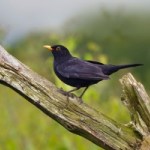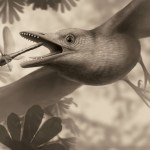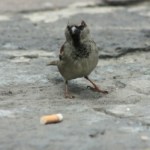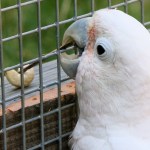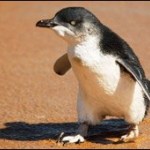bird
Dr. Pierre Legagneux (University of Quebec in Rimouski, Canada) and Dr. Simon Ducatez (McGill University, Canada) published a new study in Biology Letters suggesting that birds judge the speed limit of cars to determine when to take flight. In areas with higher speed limits, birds were observed to take off sooner than areas with lower posted speed limits.
Birds Adapt to Posted Speed Limits by GeoBeats
Find out why most species of birds do not have a penis in this video abstract of new research published yesterday in Current Biology:
Source
Herrera AM, Shuster SG, Perriton CL, Cohn MJ. Developmental basis of phallus reduction during bird evolution. Current Biology Published online June 6, 2013. doi: 10.1016/j.cub.2013.04.062
Blackbird image from: Ernie Janes/naturepl.com
A recent study has provided some evidence supporting the hypothesis that light and noise pollution alters the biological clocks of birds living in cities (compared to birds living in rural areas).
Dr. Dominoni (Max Planck Institute for Ornithology, Germany) and colleagues used radio-pulse transmitters attached to European blackbirds (Turdus merula) living in Munich, Germany (city) and those living in a forest nearby to track the animal's activity levels. They found that blackbirds living in the city showed…
Image Credit: Stephanie Abramowicz
Image Credit: Stephanie Abramowicz
Researchers have unearthed a fossil of a robin-sized bird (Sulcavis geeorum) from the Cretaceous Period in China that had teeth! This species belonged to a class of birds with teeth (Enantiornithines) that were plentiful in the age of the dinosaurs. However, the teeth of this well-preserved specimen were different. The teeth were sharp and had serrated ridges. The researchers think the ridges observed on the teeth were designed to crack open insects with hard shells, snails or perhaps even crabs. What I also found…
House sparrow in Mexico City. Photo Credit: © Víctor Argaez
Researchers Suárez-Rodríguez et al., observed house finches (C. mexicanus) and sparrows (P. domesticus) on the National University of Mexico campus in Mexico City routinely pulling apart cigarette butts to obtain the filters. The birds were found to incorporate the filters in their nests leaving researchers to speculate the purpose of used cigarette butts. Using heating elements to attract parasites, they found that probes covered in "used", i.e. artificially smoked, cigarette butts attracted fewer…
Check out this picture of a captive cockatoo (Cacatua goffiniana) in the Department of Cognitive Biology at the University of Vienna using a tool:
Image from: Scientific American
Figaro (shown above) was observed by a student using a piece of bamboo to try to retrieve a dropped pebble. This was the first documented evidence of a Goffin's cockatoo attempting to use a tool so the researchers decided to try a little experiment. They placed a cashew just outside of Figaro's cage and observed as Figaro attempted to retrieve it using a stick he found on the floor of the aviary. When that was…
One of those really cool and useful "evolution stories" gets verified and illuminated by actual research. And blogging!
An oystercatcher is a wading bird of the family Haematopodidae, distributed in one genus, Haematopus. As is the case with many coast loving birds, there has been confusion about the limits of the 11 or so species known to exist worldwide. That itself is an interesting story (Hocke 1996), but one we will not go into now.
Adult coastal oystercatchers (some species are not coastal) eat all sorts of animals found in the intertidal zone, including shellfish of all sorts,…
A bufflehead duck (Bucephala albeola), photographed at the Bronx Zoo.
A Steller's jay (Cyanocitta stelleri), photographed at Bryce Canyon National Park, Utah.
The skeletons of female (larger, background) and male (smaller, foreground) Dinornis robustus, with a pigeon skeleton for comparison. From Allentoft et al 2010.
A little more than 700 years ago, multiple species of the gigantic, flightless birds called moas were still running around New Zealand. They ranged over almost the entirety of the North and South Islands, from the coast to the mountain forests, but when the Maori people arrived in the late 13th century the birds were quickly driven to extinction. Within a few hundred years they were entirely wiped out (along with the immense Haast…
A keel-billed toucan (Ramphastos sulfuratus), photographed at the Central Park, Zoo.
A short-billed dowitcher (Limnodromus griseus), photographed in Cape May, New Jersey.
Hold your arms out with your palm oriented vertically, as if you were trying to shake someone's hand. Now without moving your forearm, bend your hand downwards towards the floor. Unless you are freakishly flexible, you will only have managed to a measly acute angle. But if you were a bird, you could bend your wrist so that your hand pointed back towards your body. These incredibly flexible wrists allow birds to fold their wings and they help with flying. And many dinosaurs could do something similar.
Many older depictions of small raptors, including the Jurassic Park films, have them…
Orchis Nodulosa
Kate Street
The delicacy of Kate Street's pencil drawings belie their sinister undertones: a garden of chimeric orchids flowering with skulls, intricate skeletons of birds perching on leaves, tuberous roots that are half heart and half honeycomb. Her installations, on the other hand, pull no punches. In Bird in the Hand II, disembodied hands clinically display the fragments of a dissected bird.
Street told London's Timeout.com,
My interest in nature is how we like to classify it and manicure it and make it perfect. I like Dutch still lifes of flowers and animals because…
This is the continuation of a discussion of loons, skeptically viewed. I am not skeptical about loons themselves. I know they exist. In fact, I just spent the last half hour watching Mom and Dad loon (whom I cannot tell apart, by the way) feeding Junior I and Junior II (whom I also cannot tell apart) what I have determined to be mostly crayfish, but also the occasional minnow.
In this installment of How the Loon Terns we will look at breeding success.
In this installment of How the Loon Terns we will look at breeding success.
Common Knowledge: When a pair of loons fails to breed, it…
Cities are noisy places. If you ever get annoyed by the constant din of traffic, machinery and increasingly belligerent inhabitants, think about what songbirds must think. Many birds rely on songs to demarcate their territories and make their advances known to mates. They listen out not just for the sounds of seduction or rivalry, but for approaching predators and alarm calls that signify danger. Hearing these vital notes may be the different between life and death.
Last year, I wrote a feature for New Scientist about the effect that urban noise has on songbirds. Those that can't make…
Whether you call them Little Penguins or Fairy Penguins, the name rightfully suggests that this species is not the most formidable of their flightless family. In fact, standing at about only 16" high, they are the smallest of all penguins. Therefore it might not be surprising that they are picked on by other species.
The "McFly" of the penguin world
Well wedgies are one thing, but a string of grisly fairy penguin murders, nine so far, has prompted Australia to break out the big guns, literally. Two professional snipers have been dispatched to a national park near Sydney Harbor to even the…
There is a reason why there are no dinosaur geneticists - their careers would quickly become as extinct as the 'terrible lizards' themselves. Bones may fossilise, but soft tissues and molecules like DNA do not. Outside of the fictional world of Jurassic Park, dinosaurs have left no genetic traces for eager scientists to study.
Nonetheless, that is exactly what Chris Organ and Scott Edwards from Harvard University have managed to do. And it all started with a simple riddle: which came first, the chicken or the genome?
Like almost all birds, a chicken's genome - its full complement of DNA…
For many animals, living with others has obvious benefits. Social animals can hunt in packs, gain safety in numbers or even learn from each other. In some cases, they can even solve problems more quickly as a group than as individuals. That's even true for the humble house sparrow - Andras Liker and Veronika Bokony from the University of Pannonia, Hungary, found that groups of 6 sparrows are much faster at opening a tricky bird feeder than pairs of birds.
After ruling out several possible explanations, the duo put the speedy work of the bigger flock down to their greater odds of including…
I bought a parakeet at a back alley Chinatown apothecary last week. Against the wise but curmudgeonly old shopkeeper's advice, I fed Felicia after midnight and she turned into this:
I believe it's a Barred Eagle-Owl. It ate Mathman.
